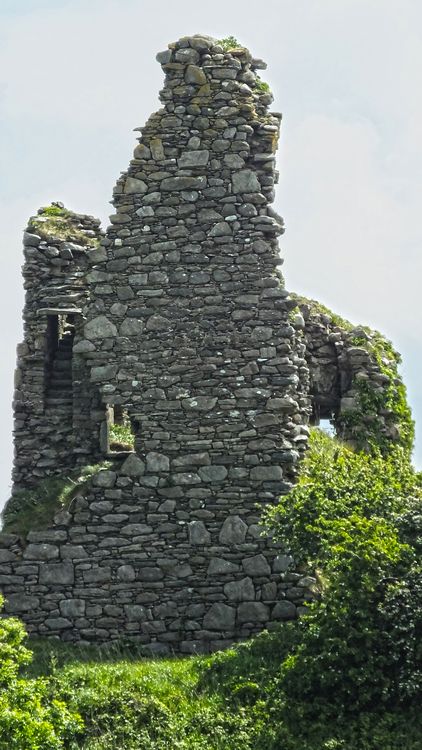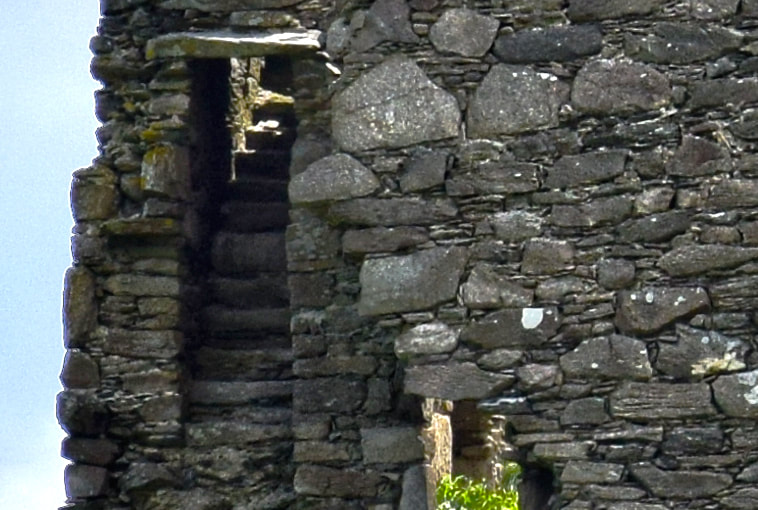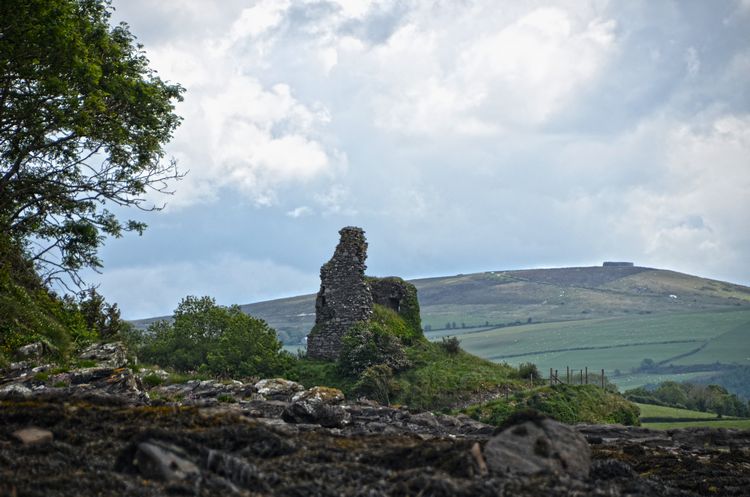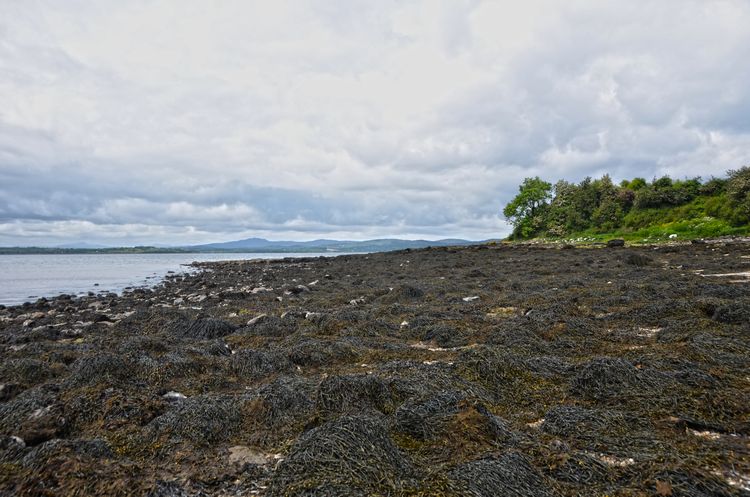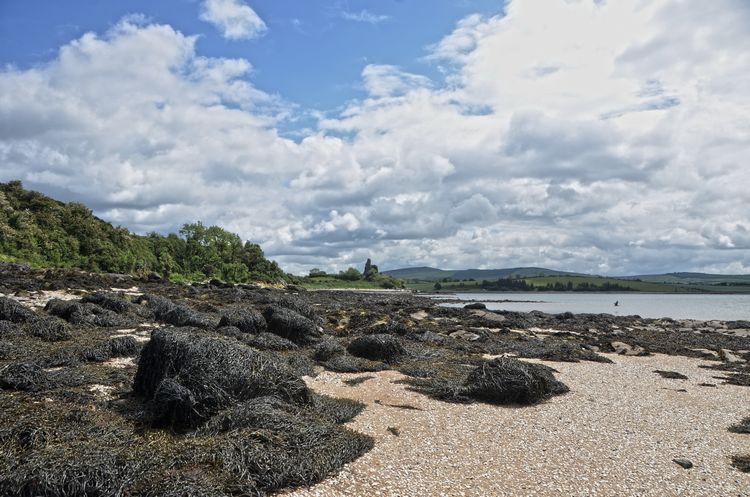INCH CASTLE
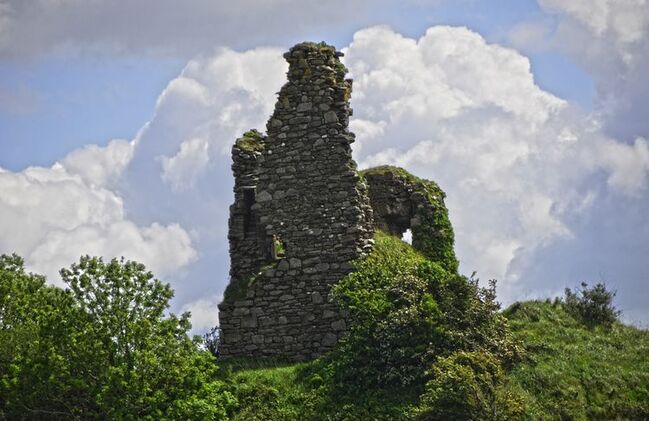 Inch Castle
Inch Castle
Situated on the rocky coastline of the south west corner of Inch Island part of the Inishowen peninsula, sits the ruins of Inch Castle, or tower house.
What we see still standing is the east half of the building that was once there and consists of three storeys. To the left on this photograph you can see the staircase (more detailed photograph below).
Inch Castle was built in the mid 15th century by the Irish chieftan Neachtain O'Domhnaill for his father-in-law Cahir O'Doherty as part of his network of defences for their territories. At the time it was built Inch Island was still an island, the causeway roads into it coming much later and so it was cut off from the mainland and a valuable viewpoint and defence point.
From wikipedia: "The Ó Dochartaigh (O'Doherty) clan were the dominant family on the nearby peninsula of Inishowen and had close links with the O'Donnells. It came to form part of the defensive network of O'Doherty fortifications designed to protect them from rival clans and to overawe those who accepted their overlordship."
A piece written in The Schools Collection:
"The mortar used was mixed with the blood of oxen so that it could bear the brunt of war and weather."
It seems that the addition of ox blood actually reduces the water absorption which would have been valuable in this instance where the castle is surrounded on at least two side by the sea.
A study from scientific.net says "… or put some animal blood in mortar to make them water repellent. Many historical monuments were protected in these old methods. In this paper, different amounts of ox blood had been added in concrete. Compressive strength, water absorption and chloride penetration tests had been conducted. In this way, the influence of ox blood on water absorption of and chloride penetration into concrete had been investigated. The results indicated that the compressive strength of concrete with addition of ox blood decreased. And water absorption and chloride penetration into concrete were effectively reduced by adding some amounts of ox blood.”
Also from The Schools Collection we learn: "The last person to live in the castle was a woman named Fanny McCloskey who kept a shebeen. (Illegal drinking house)."
What we see still standing is the east half of the building that was once there and consists of three storeys. To the left on this photograph you can see the staircase (more detailed photograph below).
Inch Castle was built in the mid 15th century by the Irish chieftan Neachtain O'Domhnaill for his father-in-law Cahir O'Doherty as part of his network of defences for their territories. At the time it was built Inch Island was still an island, the causeway roads into it coming much later and so it was cut off from the mainland and a valuable viewpoint and defence point.
From wikipedia: "The Ó Dochartaigh (O'Doherty) clan were the dominant family on the nearby peninsula of Inishowen and had close links with the O'Donnells. It came to form part of the defensive network of O'Doherty fortifications designed to protect them from rival clans and to overawe those who accepted their overlordship."
A piece written in The Schools Collection:
"The mortar used was mixed with the blood of oxen so that it could bear the brunt of war and weather."
It seems that the addition of ox blood actually reduces the water absorption which would have been valuable in this instance where the castle is surrounded on at least two side by the sea.
A study from scientific.net says "… or put some animal blood in mortar to make them water repellent. Many historical monuments were protected in these old methods. In this paper, different amounts of ox blood had been added in concrete. Compressive strength, water absorption and chloride penetration tests had been conducted. In this way, the influence of ox blood on water absorption of and chloride penetration into concrete had been investigated. The results indicated that the compressive strength of concrete with addition of ox blood decreased. And water absorption and chloride penetration into concrete were effectively reduced by adding some amounts of ox blood.”
Also from The Schools Collection we learn: "The last person to live in the castle was a woman named Fanny McCloskey who kept a shebeen. (Illegal drinking house)."
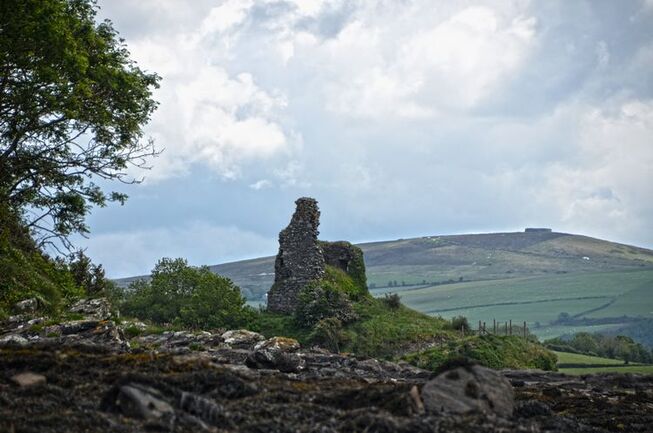 Inch Castle with Grianan of Aileach in the background
Inch Castle with Grianan of Aileach in the background
From the shoreline just west of the Castle you can see the fort of An Grianan of Aileach sitting high above it.
It was at a Holy Well near this fort that the Inishowen chieftans, Owen O'Neill was said to have been converted to Christianity and baptised by St. Patrick.
It was at a Holy Well near this fort that the Inishowen chieftans, Owen O'Neill was said to have been converted to Christianity and baptised by St. Patrick.
|
NOTES
Currently access is only possible by walking along the rocky shoreline when the tide is fully out. You MUST check locally about the tide as if it comes in, there may be nowhere to escape it given some steep sides up to land there. The walk is over lots of seaweed too making the walk dangerously slippy in places so proper hiking boots should be worn and great care taken. The castle sits on private land and under no cicumstances are you allowed to enter without the permission of the landowner. No-one is now allowed near the castle as it is in a perilous state and therefore dangerous. |
